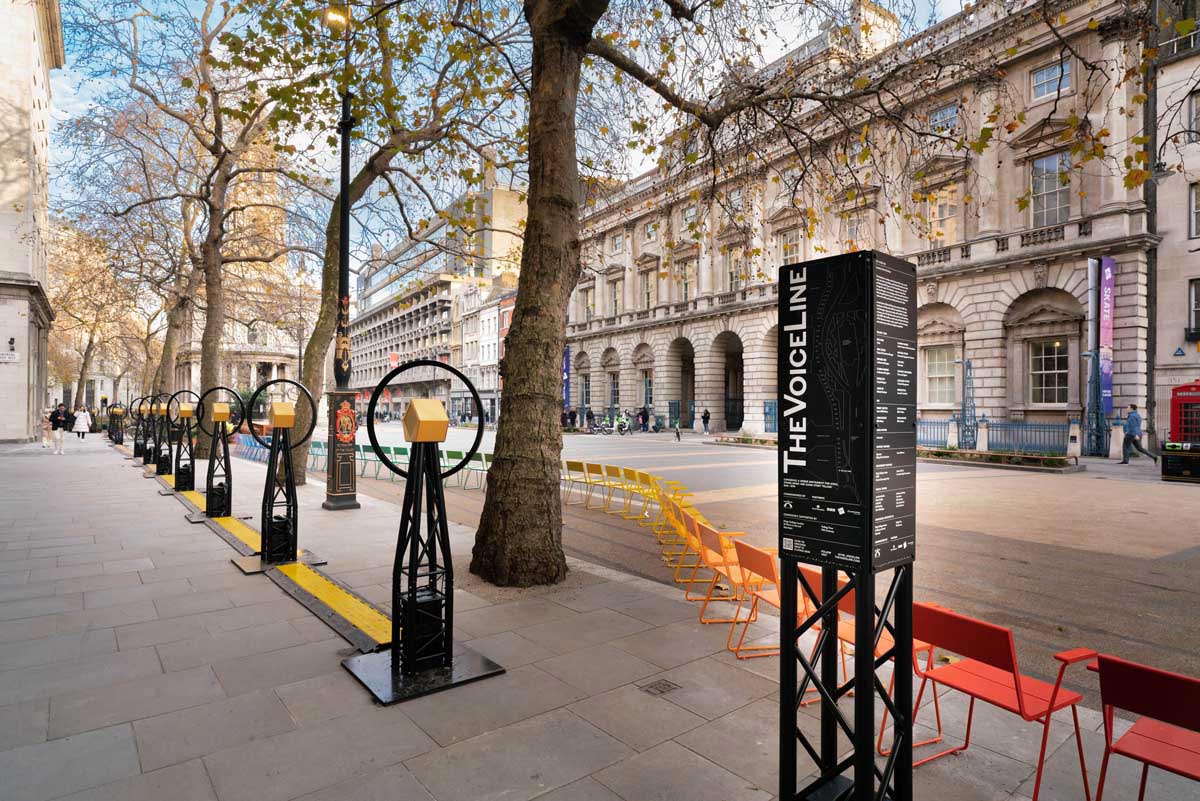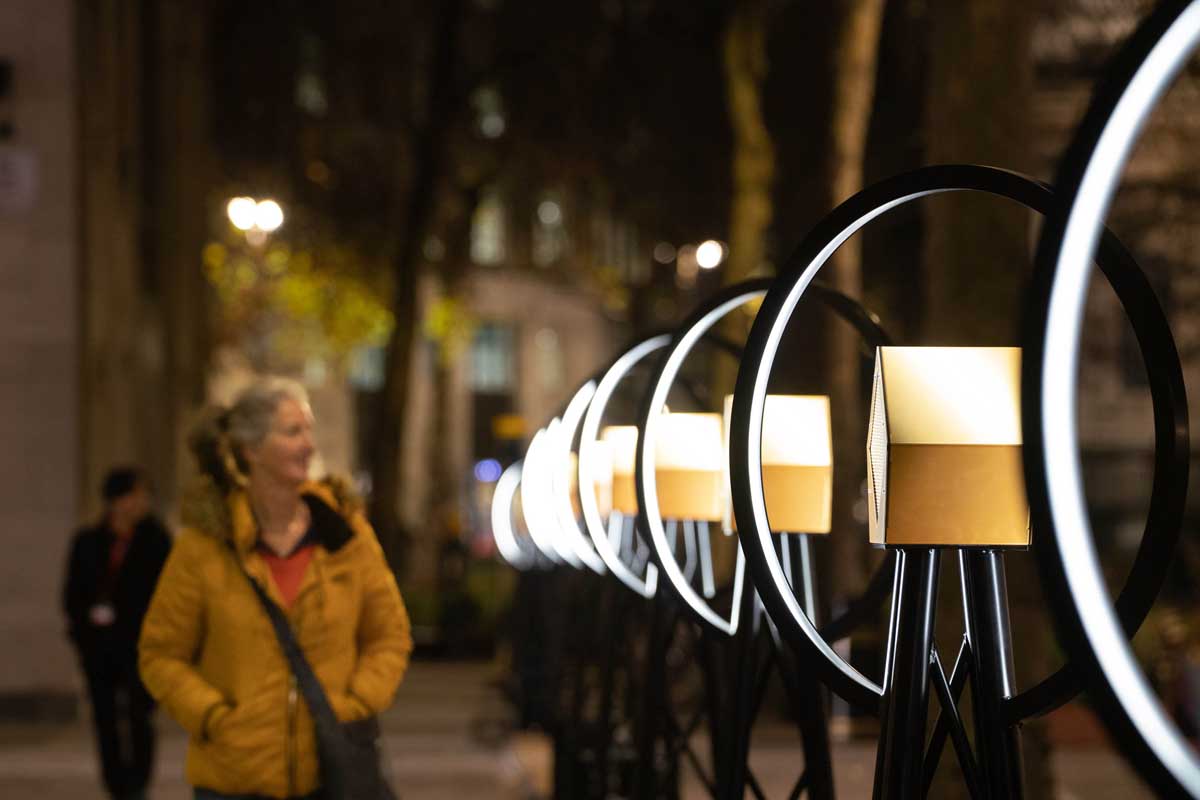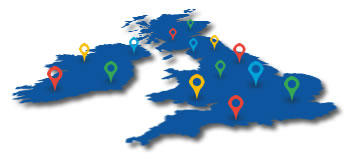
Artist, Composer and Sound Designer Nick Ryan on transforming London’s Strand Aldwych into an immersive audio installation…
The Strand is one of London’s oldest and most iconic streets. A major artery in the heart of the city, the road runs roughly parallel along the north side of the river Thames, and is believed to date all the way back to the original Roman settlement of Londinium.
From Fleet Street on its eastern border to Trafalgar Square in London’s West End, The Strand today remains a busy thoroughfare for tourists and commuters – lined with cafes, pubs and restaurants, and home to famous buildings like The Savoy Hotel, as well as art and design mecca Somerset House.
In December 2022, Westminster Council made the decision to fully pedestrianise a section of The Strand in Aldwych, dedicating around 7000 metres squared – roughly the size of a football pitch – into a new public space. The area’s rich and fascinating history is now open for visitors to enjoy and explore at their leisure, renovated into ‘a place of peace and calm inside the often-frantic central London’.
In fitting with its transformation into a new creative hub, Westminster Council have commissioned a variety of art installations and upcoming events for the location, the first of which is an experimental instrument / immersive audio exhibit designed by artist Nick Ryan.
Produced in partnership with the BBC, ‘The VoiceLine’ is currently adorning The Strand Aldwych with a daily programme of bespoke spatial audio, paying homage to the area’s historical broadcasting legacy, and delighting visitors through an evolving pathway of sound, delivered by a line of 39 highly focused speakers.
Award-winning Composer, Sound Designer and resident Somerset House artist Nick Ryan kindly spoke to Synthax UK about this fascinating project, which is powered by a selection of RME Audio AVB and MADI interfaces.
 Celebrating 100 years of the BBC
Celebrating 100 years of the BBC
First up, a quick history lesson! One of the many interesting facets of The Strand is its links to the BBC, with 2022 marking 100 years since the founding of the UK’s beloved national broadcaster.
London’s first radio transmission was broadcast on 11th May 1922 (from The Strand’s Marconi House) via ‘2LO’, a medium wave transmitter then owned by The Marconi Company.
A pioneering telecommunications and engineering establishment, Marconi Company was founded by Italian inventor Guglielmo Marconi, who shared the 1909 Nobel Prize in Physics with Telefunken co-founder Karl Ferdinand Braun, and is widely recognised as one of the Godfathers of radio.
The BBC was formed later the same year, acquiring 2LO and beginning daily broadcasts from November 14th 1922 onwards. Twenty years later, The BBC World Service made its home in Bush House – another building located on The Strand – broadcasting news, speech and discussion across the airwaves, to a global audience in over 40 languages.
This connection between The Strand – and its place in the history of radio broadcasting – led to Northbank and Westminster Council’s commissioning of Nick Ryan, with a brief to build a new audio installation in tribute to the BBC’s centenary, and in celebration of the opening of London’s major new public space.

I heard it through The VoiceLine
“I’m a multi-disciplinary sound artist and composer,” explains Nick. “Much of my work involves applying emerging technologies to the making or listening process, or introducing people to new ways of thinking about audio.”
“I’m fascinated by auditory representations of information – language, as well as physical materiality and space – which I explore through the creation of immersive sound and multi-sensory installations, as well as bespoke instruments, interactive audio experiences, and data sonifications.”
“The VoiceLine is a unique instrument for voice, sound, music, and audio storytelling. Its creation was shaped by the new site, spanning the length of the 170m space, and draws on the vast resources of the BBC’s audio archives. Engaging the public with voices from the past; early innovations of radio, famous voices from the nation’s news and the tongues of the BBC World Service, as well as the multi-layered history of the Strand itself.”
Visitors to The VoiceLine encounter a rich sonic tapestry of unique spatial sound, comprised of both archive and original recordings and compositions. The programme includes early radio broadcasts, spatial urban field recordings of cities from around the world, as well as natural environments, from the forests of Canada, to the sound of melting ice in the Arctic.
Additional works include ‘visions of the future’ gathered from Kings College London students; recreations of the Strand’s pre-industrial traffic; experiments with sound from The BBC Radiophonic Workshop (and others); and the mysterious and often ominous utterances of ‘Number Stations’ – coded messages broadcast by foreign intelligence agencies.
“The installation itself is delivered from 39 L-acoustics 5XT speakers, powered by 10 x LA4X four channel amplifiers,” Nick continues. “Audio is supplied via AVB to the amplifiers using an RME Digiface AVB interface, connected to a high-power Mac running Qlab and Max MSP.”
“We also have a secondary, fallback / parallel system providing redundancy using an RME MADIface USB, which allows the system to switch over automatically in case of failure to the primary Mac.”
“This setup allows me to creatively generate content for the VoiceLine, which exploits the spatial extent of the installation along the street.”
“For example, each speaker at times features a different voice speaking from the BBC radio archive. Other times, arpeggiated musical melodies and field recordings can travel up and down the full length of the installation.”

Fathom, Adrift and Machine 9
Alongside his creative installation pieces, Nick Ryan has collaborated with a wide range of artists and organisations including the BBC, MIT Media Lab, Imogen Heap, Underworld, The London Contemporary Orchestra and many others.
He’s also a critically-acclaimed Composer and Sound Designer for TV, Film and Radio, being the recipient of two MPSE Golden Reels for his work in sound design, as well as winning a BAFTA for Technical Innovation for ‘The Dark House’ in 2004 (a ground-breaking interactive binaural Radio Drama which he co-devised, scored and mixed live on air for BBC Radio 4).
It was his work on the film Fathom however – a unique documentary that follows two scientists on a quest to decipher the complex communication of whales – that saw Nick awarded an Emmy for Outstanding Sound 2022.
Fathom — Official Trailer | Apple TV+
See more videos at Synthax TV
For a perfect example of how Nick fuses these worlds – Sound Design, Installation and Instrument Creation – look no further than his recent project ‘Adrift’. A collaboration with film maker Cath Le Couteur, Adrift is a triadic exploration of the hidden world of Space Debris via a short film, an interactive experience, and a stunning experimental instrument named ‘Machine 9’.
 “Most people would be really surprised if you told them there were 200 million pieces of space junk under 1cm in diameter, surrounding the earth, as close as 160km away,” Nick says of Adrift.
“Most people would be really surprised if you told them there were 200 million pieces of space junk under 1cm in diameter, surrounding the earth, as close as 160km away,” Nick says of Adrift.
“As a sound artist, I’m really interested in things that don’t make sound, because for me they provide this amazing opportunity to invent a voice for things.”
“Machine 9 transforms space debris in the upper atmosphere into sound, live as it passes overhead. It’s been exhibited at the Science Museum in London and MONAFOMA in Tasmania, and is currently showing at EFPL in Switzerland.”
“Solid dependability, build quality and audio fidelity”
Whether he’s composing in the studio or dreaming up the next immersive masterpiece, one constant for Nick is his choice of audio interface.
“I have exclusively used RME interfaces for all of my installations, and in the studio, for over 10 years,” Nick says on the subject of studio gear. “My kit list has included the Fireface UFX – both the original and the UFX II – as well as the Fireface UCX, MADIfaces, the Digiface AVB, and the ARC USB remote.”
 “They’re reliable, dependable and have solid build quality, and consistently provide the extremely high-quality audio that I demand, whether it’s for capture or playback.”
“They’re reliable, dependable and have solid build quality, and consistently provide the extremely high-quality audio that I demand, whether it’s for capture or playback.”
“The drivers are also always kept up-to-date, and compatible with emerging operating systems. So many others fail due to software incompatibilities, and very few products are able to withstand 24/7 use over long periods of time in my experience. RME interfaces seem to work flawlessly day in, day out, and I always have faith that they will ‘just work’.”
“I have exclusively used RME interfaces for all of my installations and in the studio for over 10 years”
“TotalMix FX has also become an essential part of my studio setup, and in the construction of sonic installations. The kind of work I do often involves huge numbers of input and output channels, and TotalMix allows me to route anything to anywhere very easily and logically, as well as applying its DSP effects such as EQ and Reverb. This keeps these intensive processes away from the CPU of the computer, which is again hugely useful when tuning a system in a gallery or on the street.”
“Finally, I also make frequent use of the Fireface UFX’s Durec feature (also found on the Fireface UCX II), printing large mixes as polywavs. Having the option to record all channels to a thumb drive, directly from the front of the interface, is incredibly useful when I’m recording.”
“very few products are able to withstand 24/7 use over long periods of time in my experience”
 Our thanks to Nick Ryan. The VoiceLine runs on The Strand until April 17th 2023. Fathom (Emmy Winner 2022 for Outstanding Sound) is available to watch on Apple TV+ here.
Our thanks to Nick Ryan. The VoiceLine runs on The Strand until April 17th 2023. Fathom (Emmy Winner 2022 for Outstanding Sound) is available to watch on Apple TV+ here.
To find out more about Nick Ryan’s work, visit his website at www.nickryanmusic.com .
Photos courtesy of Mickey Lee.
See the full range of RME MADI products
See the full range of RME AVB, Dante and Ravenna products





















